Paw&Claw
Challenge: Create a web app that enables anyone, anywhere to instantly chat with pet experts from different fields.
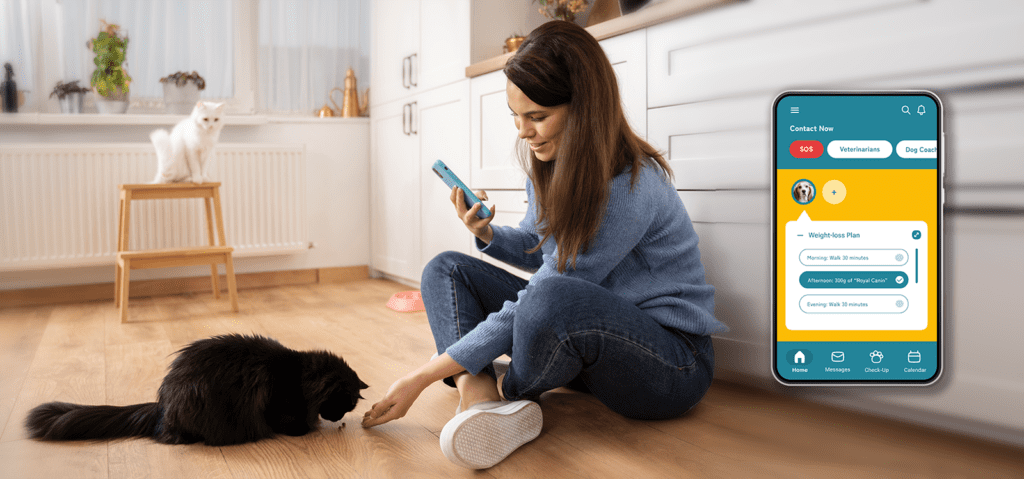
User Research
In an era where pets are cherished by 66% of households in America and 46% in the EU, the constraints of busy schedules and geographical limitations frequently obstruct access to vital pet care and expert advice.
In this case study, I will guide you through my design process for creating an app that overcomes these challenges, offering pet owners convenient access to expert guidance and services.
To ensure that I design solutions that truly tackle the needs of our potential users, I conducted research focused in delving into the everyday experiences of pet owners.
Research Conducted
Competitive Analysis
I examined key players in the market that offered solutions relevant for the challenge of this case study, such as PAWP, GoodPup, and Chewy.
These companies offer unique services ranging from emergency veterinary support and remote dog training to comprehensive e-commerce platforms for pet care.
Their strategies and offerings provided me with valuable insights for creating an engaging, user-friendly, and comprehensive pet care application:
- Personalization: Emphasize personalized pet care advice, reflecting GoodPup’s model of tailored dog training solutions.
- No Subscription: Most of the services offered by the competitors were only available after subscribing to paid long ongoing memberships. In the reviews (and later during user interviews) I found that users were more interested in one-time payment services, as they don’t look for experts so often that they justify the need for a membership.
- Ease of Access: Focus on a user-friendly interface for quick service access.
- Emergency Support: Include emergency assistance features.
- Remote Assistance: Offer remote, virtual pet care services, leveraging GoodPup’s success in virtual training.
- Community Engagement: Create community features to build a supportive network for pet owners.
User Surveys – Pet Owners
The user surveys to pet owners and potential users revealed the following key insights:
- Information Seeking: Most participants consult veterinarians for pet-related doubts, with some also using online searches and contacting pet organizations such as animal shelters.
- Online Information Habits: A significant portion of participants do not frequently seek pet-related information online, indicating a preference for direct, expert advice.
- Service Preferences: Besides veterinarian services, grooming, and pet hotels are the most used services. 30% of the participants would like to try a pet service that is not available in their area.
- Need for Veterinarian Assistance: 40% of participants reported going to the veterinarian once per year.
- Self-reported Pain Points: 40% of the participants reported not having enough time to do certain activities with their pets.
Interviews – Pet Owners
The interviews allowed me to get various qualitative insights relevant to this challenge. The insights were organized into several different topics:
- Local Services:
- On-site services should be close to the users’ location to fit their lifestyle.
- Online and remote solutions should be compatible with the user’s local on-site services
- Participants who live in rural areas have trouble finding a variety of pet services in their area
- Participants in Portugal tend to believe that online pet services are not very developed in their country, so on-site services are seen as more uncomplicated and more reliable.
2. Start Challenges:
- Pet owners tend to feel more unprepared and anxious at the start.
- Training and understanding the pet’s behavior seem to be the most challenging issues at the start of living together.
- Users seem to be more willing to invest in services for their pets at the start.
- Overall, potential users seem to have more doubts and spend more time researching information related to their pets at the start.
3. Finding Pet Information
- It can be hard for users to put the theory into practice
- Pets might be having a problem that pet owners are not aware until they are diagnosed by an expert.
- Pets might have specific needs, and such personalized tips might be hard to find.
- When searching online, the interviewees reported they use a few sources of info instead of relying on just one identity.
- Interviewees (and surveyed) mention Google as the quickest option they use to find pet info
- Some pet owners have trouble understanding certain behaviours of their pets, and they don’t know how to find this information.
4. Trustable information & experts
- Pet Owners struggle to find clear science-backed info about pet behavior
- Ultimately our interviewees tend to trust more vets than any other pet expert or entity
- Having an expert aware and interested in the background of the pet, reassures users they are interested in helping them and makes the advice more trustable and relevant.
- Pet Owners would more likely trust a pet online platform or service if it is certified by real veterinarians
- Some pet owners would feel more comfortable if their pets could have check-ups by vets more often when the pets have concerning health problems.
5. Being there for their pets
- Pet owners do not always have the time and availability to do certain activities with their pets
- Having immediate support and instructions during an emergency is important for pet owners
6. Community
- Pet owners look for support from people who understand them and have similar experiences.
- Pet owners like to ask for casual advice from other pet owners.
- Pet owners are curious about other pet owners’ experiences
- Overall, pet owners enjoy speaking with other pet owners.
7. Affordability
- Some pet owners often seek pet organizations’ support to find more affordable vaccinations and treatments
- Pet owners are worried about the prices of pet treatments and services. They would like to be aware of the pricing ahead.
In an ideal scenario, I would have included direct interviews and surveys with industry experts in this project. However, due to the constraints of it being an academic study, this approach was not feasible. Therefore, I relied on alternative data sources, such as articles and expert app reviews by veterinarians to have them in consideration too.
User Persona & Journey
For this case study, I primarily focused on pet owners, while also considering pet experts’ insights to enhance the platform’s effectiveness and relevance. While different user personas were created, most of the design choices were based on Marta, which represents the main segment of our pet owner users:

Stepping into Marta’s shoes and creating her user journey was useful in identifying opportunities and essential features for the web app:
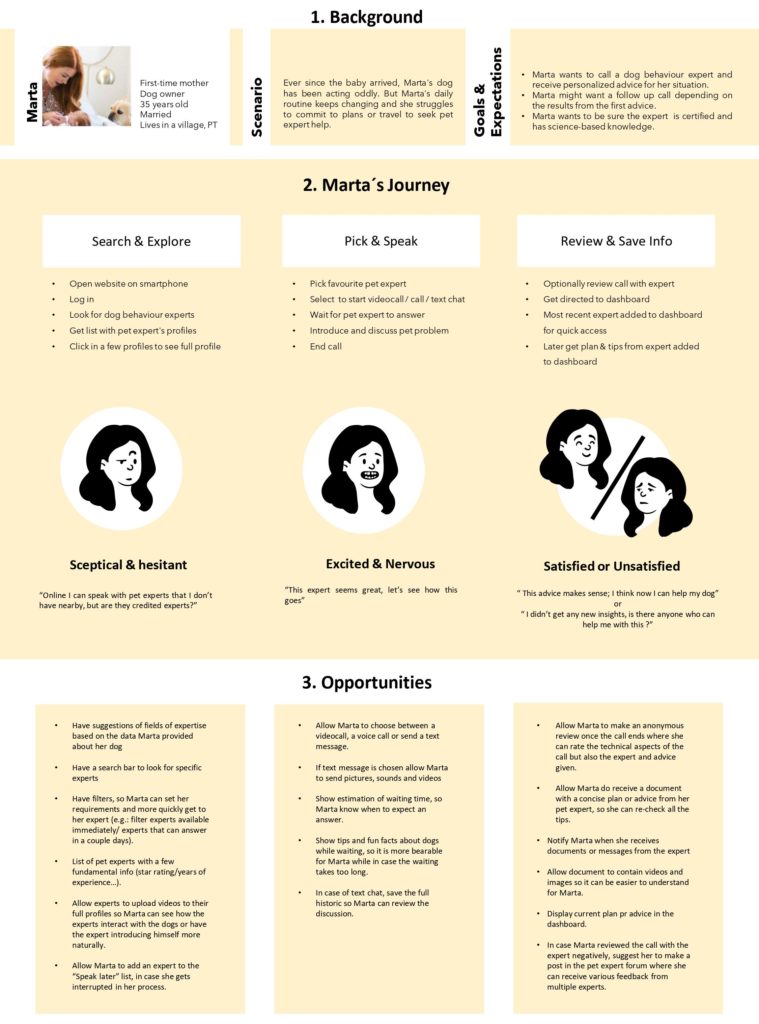
Initial Design Concept & Structure
Prior to user testing, this phase already underwent through iterations in two key steps:
- Translating user flows into initial wireframes
- Refining the sitemap based on insights gained from a card sorting session.
The card sorting session was open and it gave me valuable insights about users expectations. With these insights I reorganized the sitemap of the app so that users could find content more quickly and clearly
After I sketched the first wireframes, some problems in the first user flows became more evident and were revised.
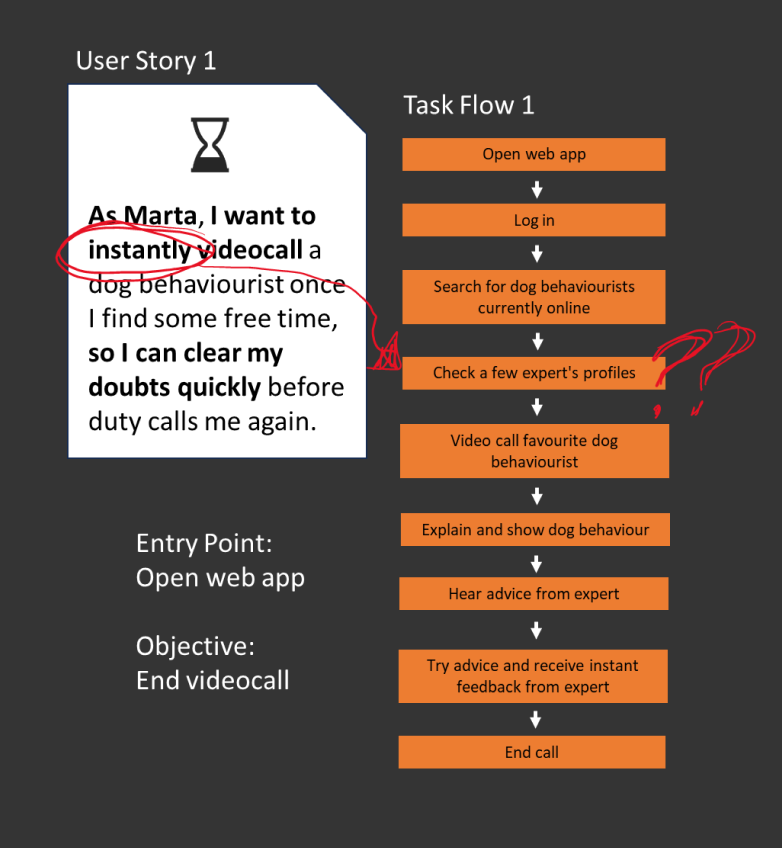
Solution 1: Expert Suggestions
Reflecting on the first wireframes and Task Flows, I was not convinced that the product would tackle our users’ needs. So after correcting the flow and sketching other wireframes, I came up with better ideas. I found that adding expert suggestions on the main screen would fit in Marta’s busy and unpredictable routine:

This solution offers Marta recommendations of experts based on her pets, her preferences, and other specific data such as frequently used services. This way Marta can quickly call the desired expert directly from the dashboard, instead of only having the option of manually searching, filtering,g and scrolling for experts.
Solution 2: Quick onboarding & Sign up
Another important factor for Marta is to quickly understand what is the web app about, how to use it, and to reach her objectives quickly. So coming up with a quick onboarding and easy solutions to sign up/login, was essential.
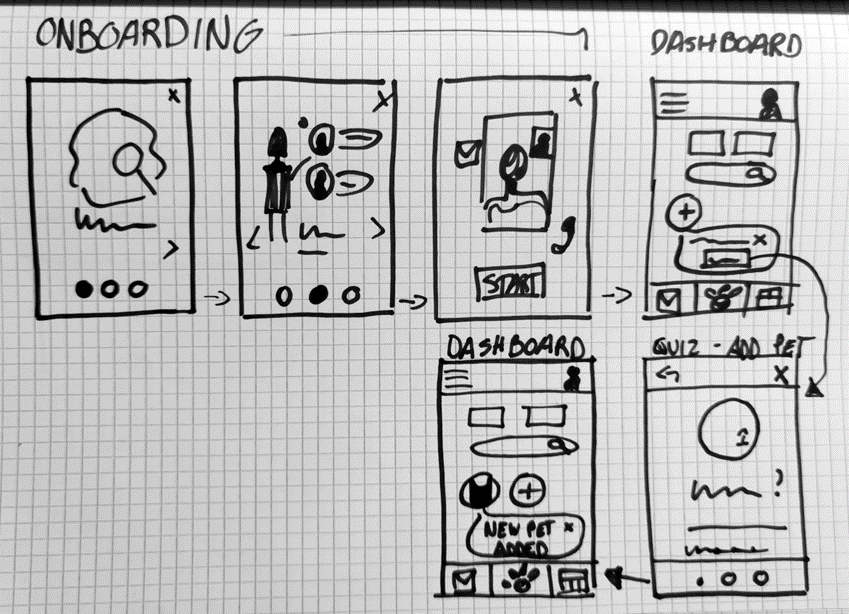
At first, onboarding was after the signing-up process.
After reviewing it I decided to start the onboarding process right at the homepage before signing up, as it gives the user a better overview of what the web app is about ahead, can help the users feel less hesitant signing up for it. After Signing up, a progressive onboarding continues to give some hints about what can you do in the platform.
The quiz was also improved: besides helping users set up their accounts and add info about their pets quickly, it also can give immediate feedback and experts suggestions customized for their pet’s needs.
Here you can see the flow starting with the homepage onboarding > signing up > add a pet quiz> quiz results > updated dashboard with personalized suggestions:
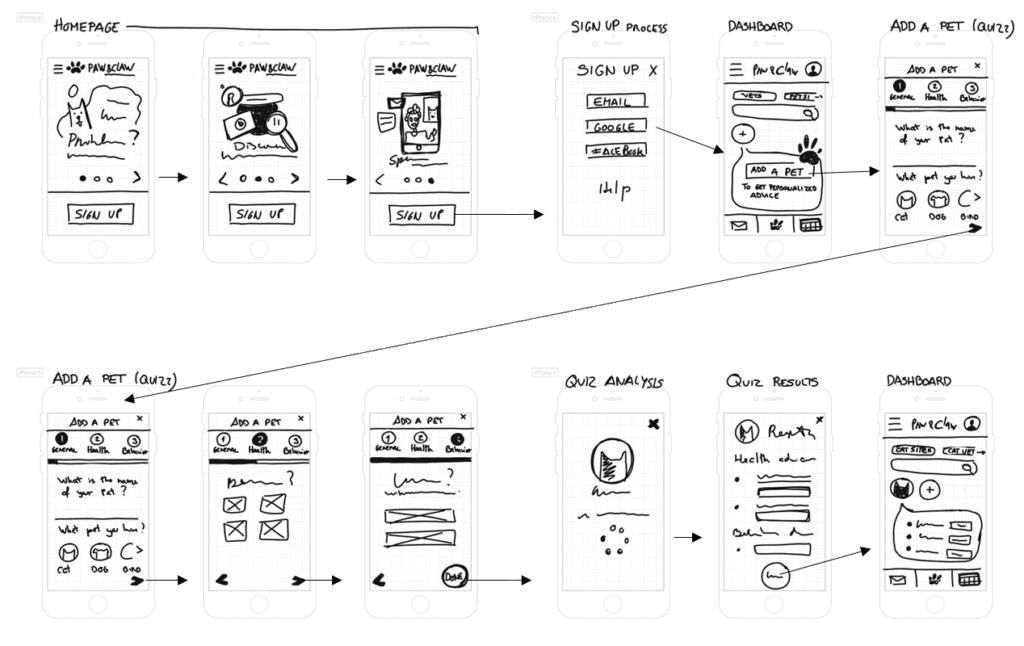
Solution 3: AI Health Check-up
During the interviews all the participants mentioned that sometimes they had doubts about their pet’s health, but they ended up waiting to see if simptoms continue or if gets worse.
Some reasons not to visit the veterinarian:
- ” I don’t want to constantly be visiting the vet for overreacting”.
- “Appointments are expensive so I wait until I have more proof that something is really wrong”.
- “I have to wait to get an appointment, I don’t always want to be bothering with phone calls for every little thing”.
Possible Consequences
- Most of participants reported feeling restless and anxious when they have doubts about their pets health, even when they didn’t have enough reasons to justify going to the veterinarian.
- Some participants also said they didn’t notice something wrong with their pet until they went for a routine check-up, they also voiced feeling guilty for not noticed something was wrong earlier.
- One participant also reported feeling unsupported through the period their dog went through a dangerous pregnancy and wanting more regular check-ups and second opinions. This participant also reported having to get to the vet emergency as the condition of the pregnant dog was previously misjudged.
To adress this problem I conceptualized a solution aimed at facilitating free preventive health check-ups for pets, an AI-driven health check-up tool.
This tool would be developed to meticulously analyze a range of symptoms and maintain a comprehensive health history for pets. This would enable it to identify patterns over time, providing an essential first line of support for pet owners.
By using this tool, pet owners are empowered to make informed decisions, having a better understanding if is necessary to consult a veterinarian. It would also assist users in monitoring their pets’ health while seamlessly integrate with our pet experts services.
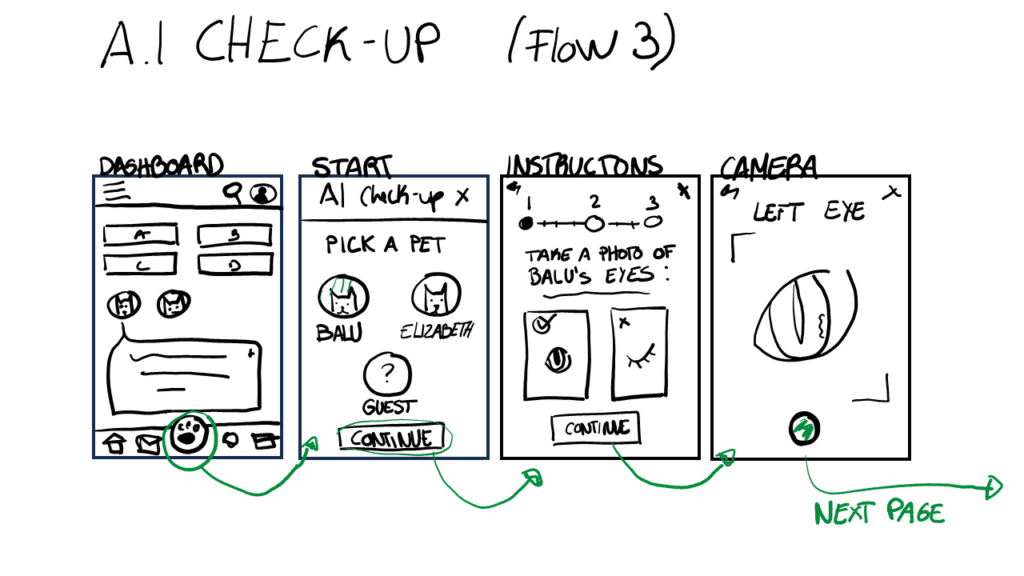
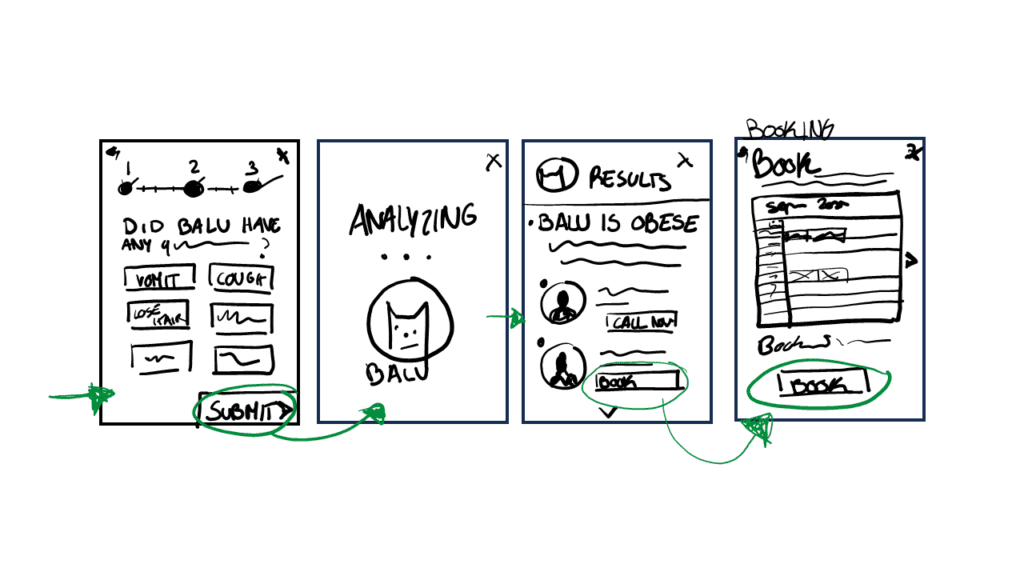
User Testing
I continued developing the wireframes and an interactive prototype to conduct moderated usability tests.
The participants were 6 pet owners (5 remote and 1 in-person session).
Each session lasted about 15 minutes, participants completed tasks and shared their thoughts while interacting with an online prototype.

Background
• Paw&Claw is a project for a web app that allows users to speak with pet experts remotely and find personalized advice about their pets.
• This project focuses on providing convenient and accessible ways for pet owners to get expert advice.
.

Goals
• Find errors and obstacles for users when they are looking for expert advice.
• Observe how users explore and perceive all the main functionalities of the platform.
• Learn how easy it is for users to input data about their pets.

Objectives
• Understand the user comprehension of the platform and value.
• Observe how users navigate and find experts from the dashboard
• Determine if participants can find the A.I health check-up and understand its purpose.
• Evaluate user difficulty in inputting pet data.
Full User Test Script
Introduction
Hello, my name is Joana. I’m working on a prototype for website where users can contact pet experts for advice. I’d love for you to help me test my prototype and give me feedback on how I can improve it. So, this is not really a test, there is no right or wrong choices, this is a way for me to understand what the website is missing and obtain new insights on what can be improved.
This session should take about 10 to 15 minutes to complete. During the session, I’ll ask you to complete a series of tasks and give me your thoughts on the overall usability of the app.
Please feel free to ask me any questions you have during the test.
Thank you for your time and participation!
Demographic Questions
- What is your age range?
- What is your current occupation?
- How many pets do you have?
- What type of pets do you have?
- How often do you seek advice about your pets?
Background Questions
- Have you ever used a website or app to call or text any kind of experts before?
- If so, what did you like and dislike about the website/app?
- What are your expectations for an online platform that allows users to call or text pet
experts?
Open-Ended Questions
Thank you for answering those questions. Now, I’d like to show and start by getting your initialimpressions of the app.
Spend some time looking over this [the home screen] screen. Without clicking anywhere just yet, can you tell us your first impressions?
What you like and don’t like, what you think about the information displayed on the page, or any other thoughts you might have?
Please just sign up in the platform and then stop. Now, take a few minutes to look at this page [Dashboard] what do you think about it? What are you inclined to do next?
Tasks
1: Sign up
2: Please create a profile for your dog in this platform.
3: (After getting the results from adding a pet) You are familiar with the obesity problem from your pet, you have tried many things but nothing worked for Balu to lose weight. You have some time now and you would like to speak about this with a veterinarian. You can’t do noise though because a baby is sleeping near you. How would you contact the veterinarian? (Please contact the veterinarian and return to the dashboard when you are done)
4: Some weeks passed and you wonder if everything is okay with your dog, Balu. He seems to be
acting a bit different. It’s time to do an AI check up to Balu! (Please find how to do an AI check-up)
5: (After getting the results from AI check up) You have to leave home soon to do some errands. So, you want to quickly contact a vet before, to show him your dog state better and to ask what medicine could you buy for Balu on your way back home. How would you contact the vet? (Note how the participants decides to contact the vet, but then instruct them to pick videocall).
Wrap-up
Okay! That’s the end of the session. Thank you for participating and helping me better understand how I can improve Paw&Claw. Before you go, do you have any other questions or feedback for us?
User Testing Report
The user testing allowed me to identify important issues with the design of the app. In the following slides are the main 5 issues found and the respective interations implemented at this point:
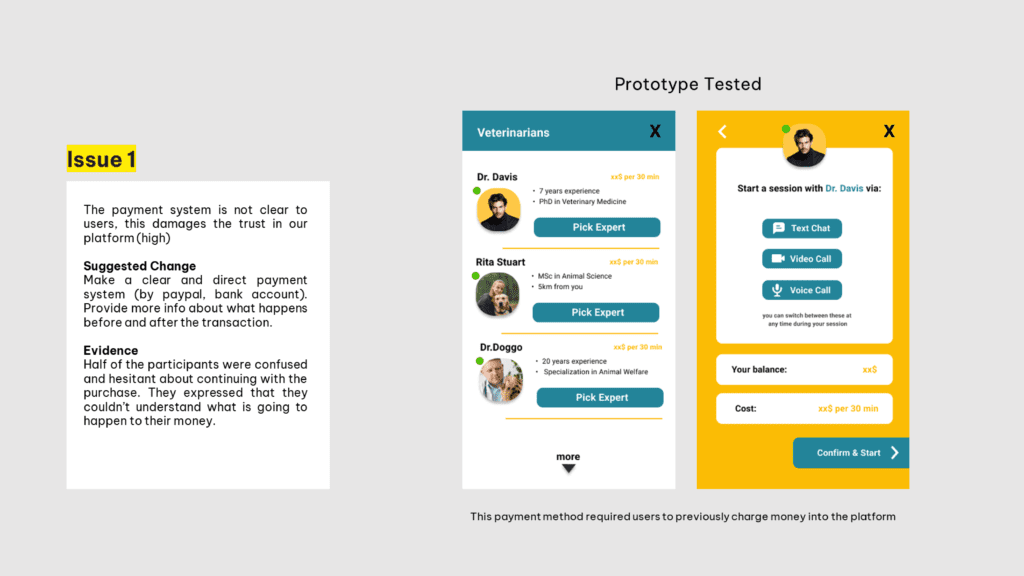
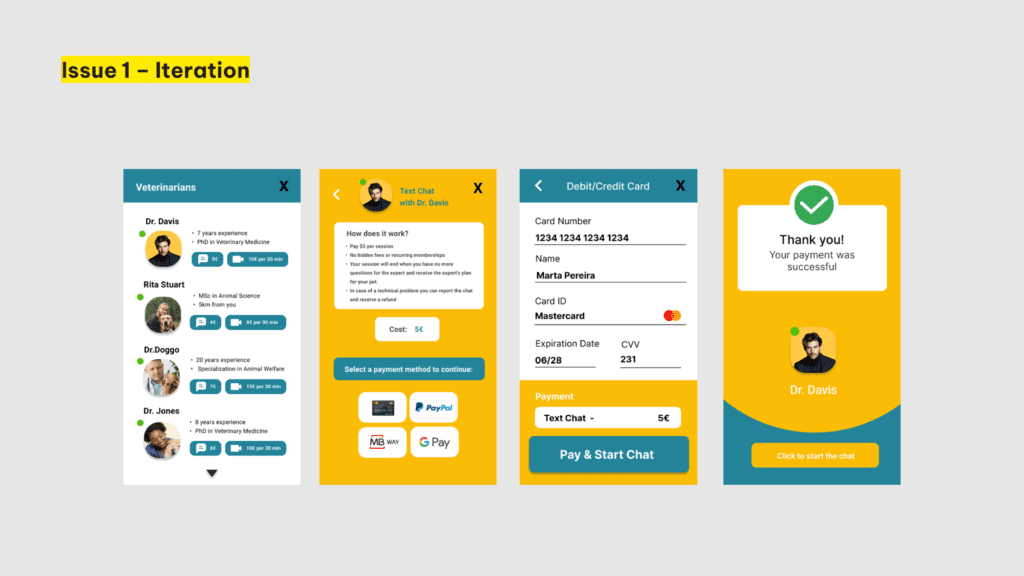
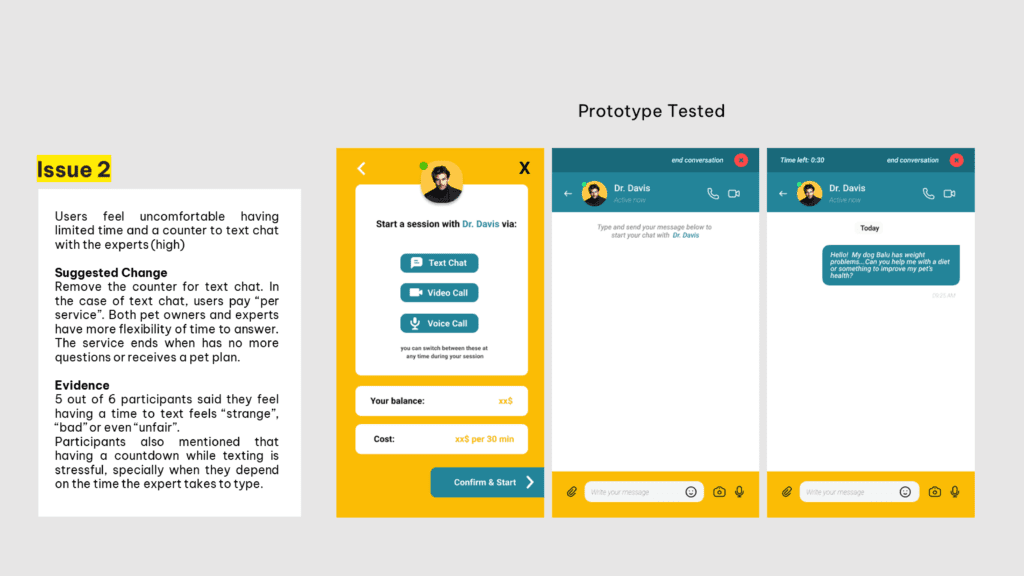


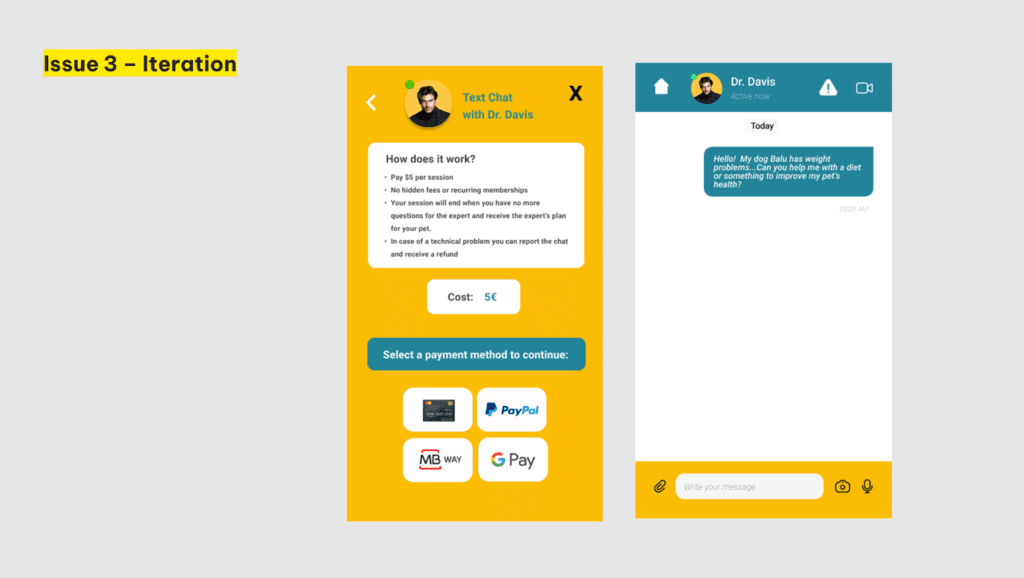
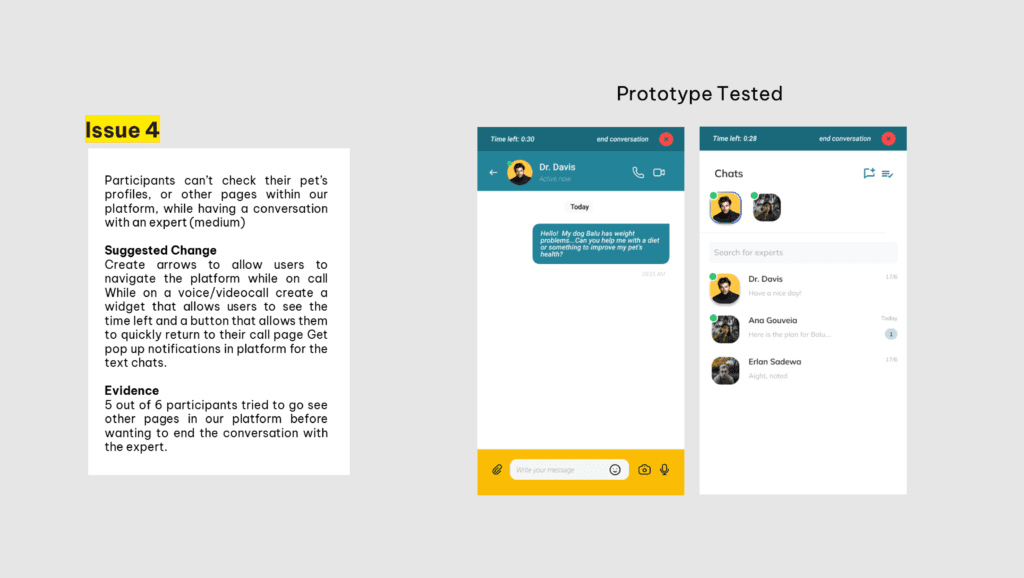



During this testing session I tested the sign-up process but not the log in. Even so, one of the participants was curious and asked “Where would I log in next time?”. The participant then found the “log in” button shortly, but it still raised the doubt:
– Can users easily find where to log in?
To answer this question I conducted a preference test, where I presented to 10 different participants, the original version of the prototype and a new version where I altered the placement of the log in button:

Preference Test Results
6 preferred the new version – B
4 Participants preferred the version A
Reasons why participants preferred version B:
• “The Log in was easier to find”
• “The know more is irrelevant for me”
Reasons why participants preferred version A:
• “The Log in was slightly easier to find”
• “The question mark in the version B was confusing”
• “There was not a significant difference to me, I picked A because it looks nicer”
Conclusions:
I decided to employ a design closer to the B version, as it was the winner, picked by 60% of the participants. However, I decided to remove the “question mark button” present in the B version because:
• The participants that picked B didn’t show any particular interest in the question mark
• 2 participants that picked B also declared that the “know more” in the A version was irrelevant for them.
• 2 participants picked the version A because the question mark in version 2 was confusing to them.

Collaborative Design &
Polishing the UI
This phase involved a more detailed reflection on my design choices, particularly reviewing aspects like hierarchy, proportion, and balance of the elements.
The goal was to create an interface that is not only aesthetically pleasing but also easier to scan and navigate, enhancing the overall user experience.
I also collaborated with other UX/UI designer to get feedback on my designs:
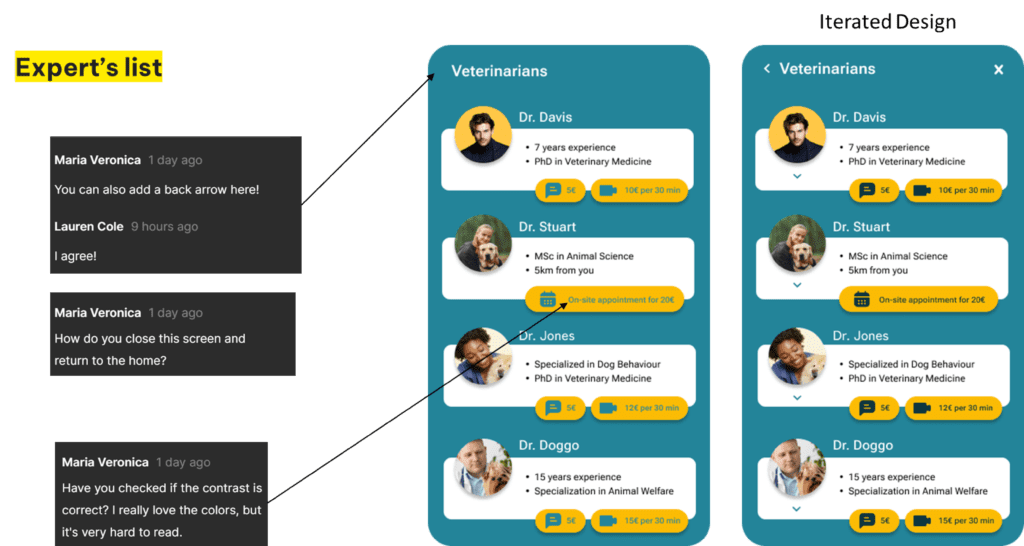
High-fi Prototype & Wireframes
Here are the results of my research and design process, where I present a collection of high-fidelity prototypes and detailed wireframes. Below, you will find a selected assortment of wireframes that illustrate the core functionalities and aesthetic considerations of Paw&Claw.
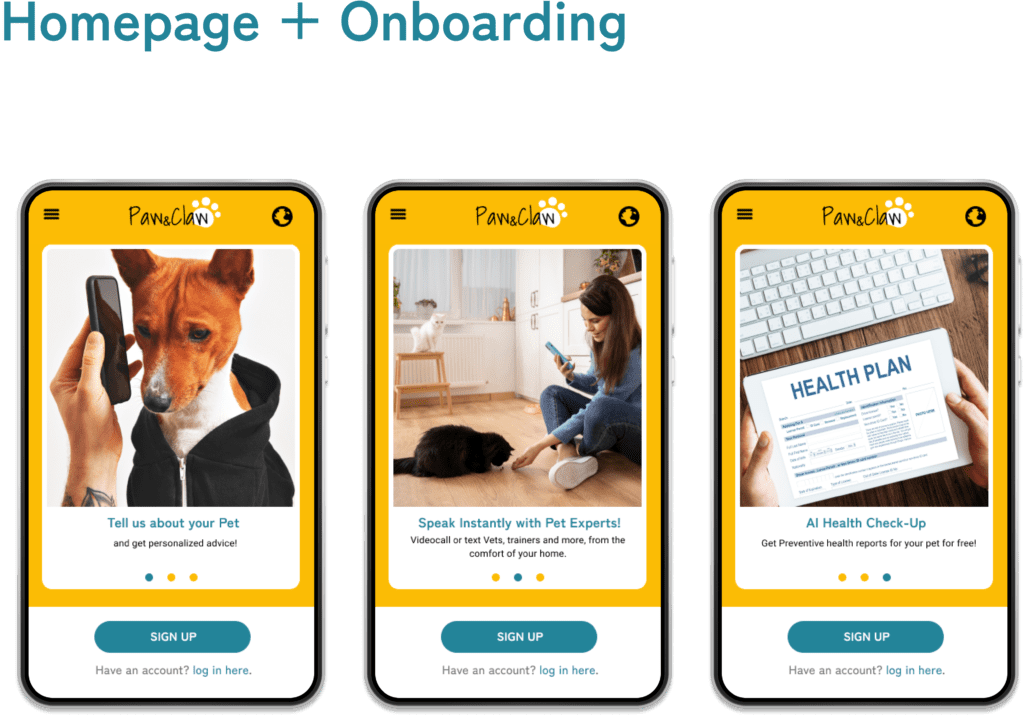
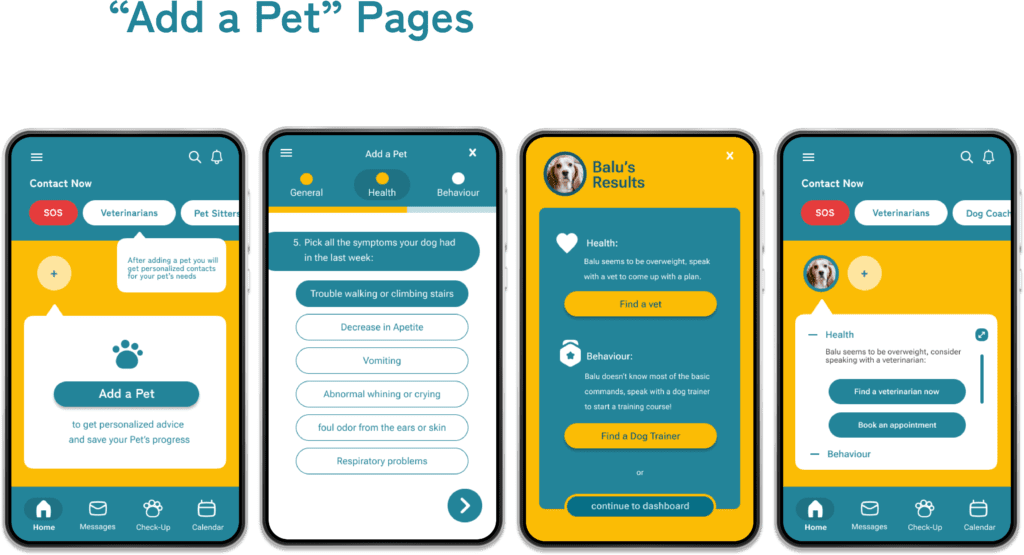
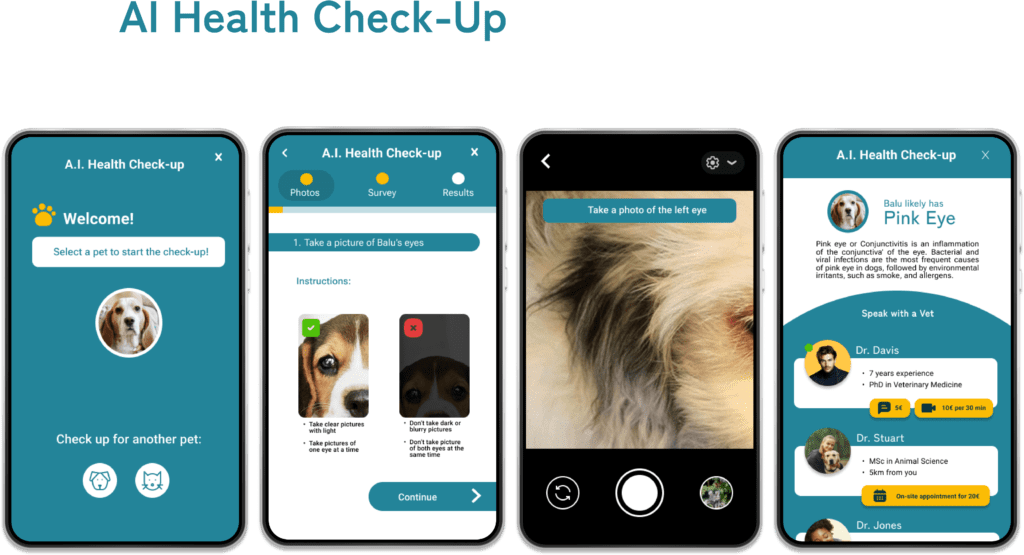
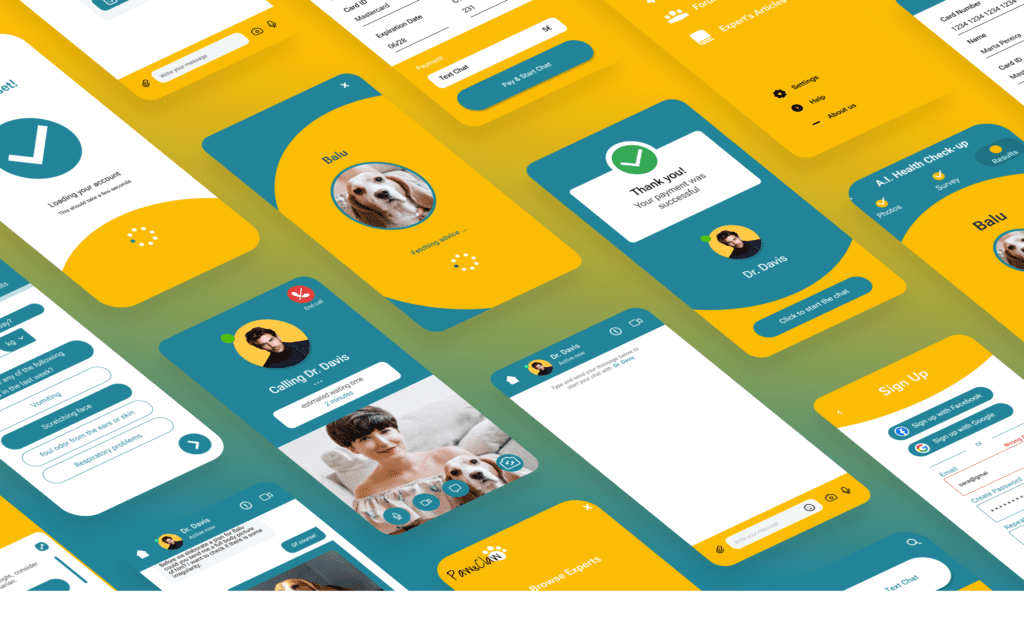
Guided Video Tour
This video below walks you through the key functionalities of the platform as I also offer a few more insights about the navigation and design choices.
Interactive Prototype
Step into the user’s shoes and engage with the various available features.
Conclusion
In this project, I focused on creating a web app that provides instant access to a variety of pet experts, driven by user feedback. I developed a platform that not only connects users with pet professionals but also introduces innovative features like personalized expert recommendations based on pet data, and an AI Health Check-up for accessible health assessments, pointing when veterinarian consultations are necessary.